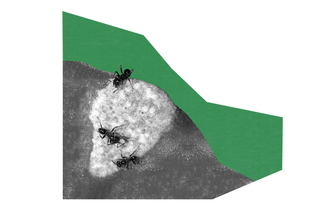
An Ant Species ‘Heals’ Wounded Trees That Give Them Shelter
The discovery was made when a boy hit a tree with a slingshot and found out the injury was repaired the next day.

Did you ever think ants could be “healing” anything — much less entire trees? Scientists didn’t either. But absurd as it sounds, it’s true.
The “healing” tendency of an ant species that is widespread in Mexico, and Central and South America came to the fore when a high-school student hit a tree with a slingshot — forming clean entry and exit ‘wounds’ — only to discover the next day that the injury had almost magically been repaired. In other words, the ‘wounds’ had been closed up.
To confirm what they accidentally witnessed, the curious group of high-schoolers — or, “the researchers” — began drilling holes in trees in the neighborhood. They noticed that each time, they were patched up by ants living inside the trees.
“I was totally surprised by the results… And I was impressed by how [the students] developed a simple way to test the idea that ants repair damage to their home,” said William Wcislo, an ethologist from Smithsonian Tropical Research Institute, who co-authored the study — and helped the five high-schoolers devise their experiment.
Published in the Journal of Hymenoptera Research, the study found that Azteca alfari ants that live inside the Cecropia trees in Panama, Central America, were behind the repairs — almost as if they were fixing up the walls of their homes.
Related on The Swaddle:
Ants ‘Kiss’ for the Benefit of Their Communities, Finds Study
“The reasoning behind hole repair behavior could be because a hole in the wall exposes the ants’ vulnerable immature stages to external pathogens, predators, or changes in other environmental parameters,” the researchers explained in the study.
They noticed that about seven to 10 ants would emerge from their homes within the trees and rush to the wounded area to begin the “healing.” Working both from outside the tree and within, they patched up the holes using plant fibers bound by tree sap.
“Once the hole was sealed they continued to apply plant materials to fill it in completely… Eventually the plant formed its own scar tissue, which differs in color, texture, and durability. The initial diameter of the opening was significantly reduced by the ants after [just] 2.5 hours,” the study notes.
The researchers also discovered the Azteca ants engaging in repairing the trees more when their eggs — housed in the trees — are at greater risk.
This appears to be just one aspect of the symbiotic relationship Azteca ants share with their kind hosts. What scientists already knew is that “the ants will do their best to defend the trees against herbivores, receiving nutritious oily secretions from the leaves to eat and shelter within hollow stems in return,” as an article on Science Alert explains.
Related on The Swaddle:
Humans Aren’t Alone, Ants Freeload on Others Too
Interestingly, “healing” behavior has been observed in another species of ants before. In a 2018 study, researchers had discovered that Matabele ants, native to sub-Saharan Africa, nursed their “comrades” back to health following battles with termites — after carrying them back into the safety of their homes. “This discovery marks the first time non-human animals have been observed systematically nursing their wounded back to health… While animals have frequently been observed treating their own wounds, there were only a few anecdotes of animals treating one another prior to this discovery,” National Geographic reported.
The study had led scientists to wonder whether other species of ants practice similar behavior. “It’s quite likely that there are other ant species, or other social insects, that tend to their wounded,” Helen McCreery, a postdoctoral fellow at Michigan State University, who studies social behaviors in ants but wasn’t involved in the study, had said.
Well, the present study seems to have partly confirmed her theory — except, instead of treating of nursing fellow ants, the Azteca species heal trees.
As humans, perhaps, we can emulate their behavior instead of cutting down trees and causing soil erosion, desertification and flooding, and ultimately, climate change — all of which harms us too. If ants can understand how protecting trees is also in their own best interest, surely humans should be able to grasp it as well. Maybe, the present study can serve as a fable of sorts, helping us learn from ants.
As Alex Wcislo from the International School of Panama, who led the study, said: “Sometimes messing around with a slingshot has a good outcome.”
Devrupa Rakshit is an Associate Editor at The Swaddle. She is a lawyer by education, a poet by accident, a painter by shaukh, and autistic by birth. You can find her on Instagram @devruparakshit.
Related


Stars May Be Forming 10 Times Faster Than Thought, Finds Study
